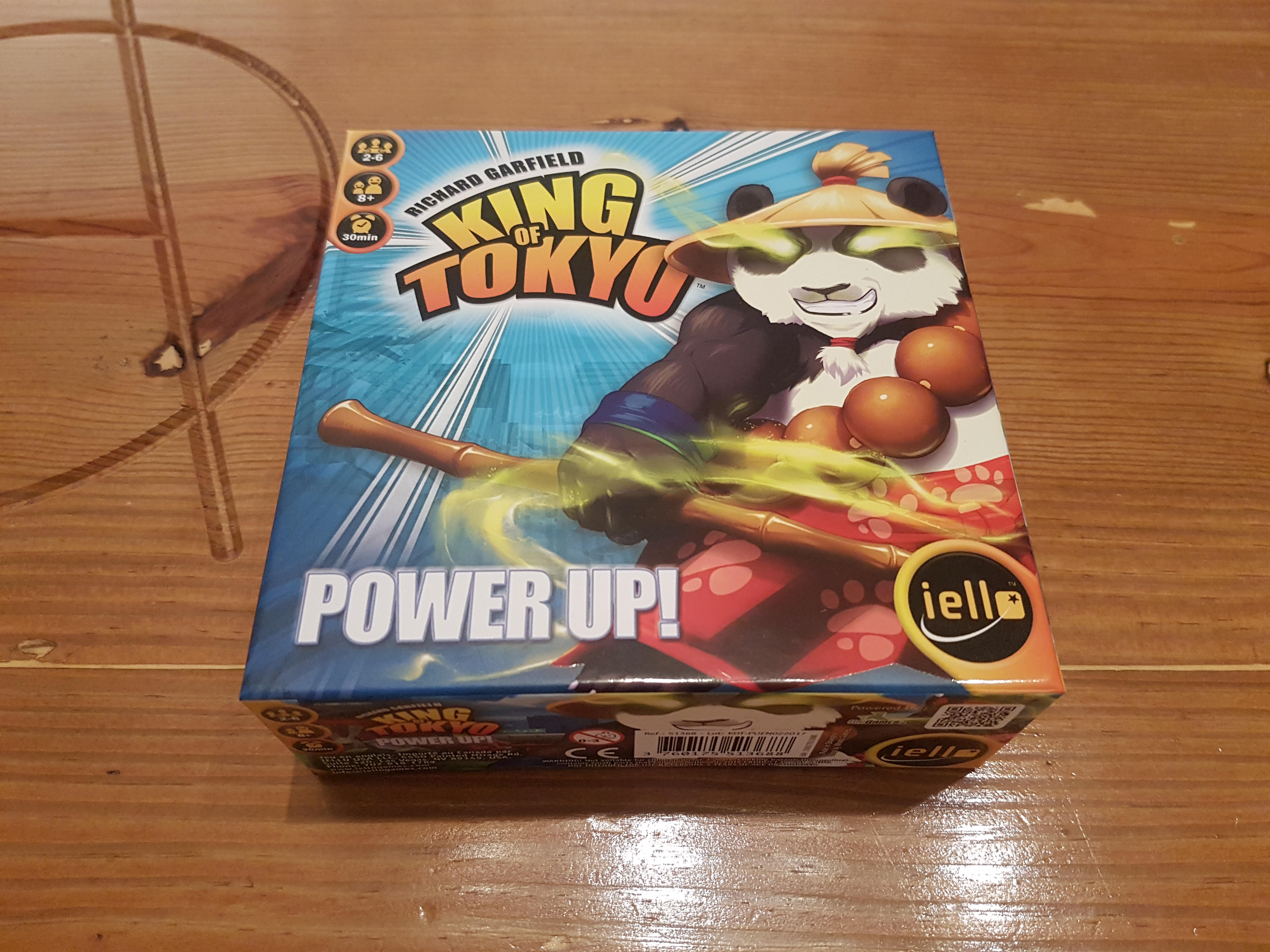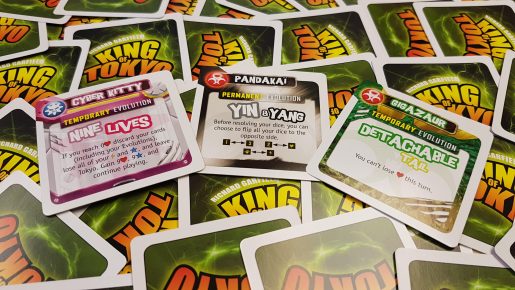King of Tokyo: Power Up! is an expansion to the base game of King of Tokyo, which takes the rolling dice mechanics and throws in variable player powers. Originally released back 2012 the Power Up! expansion was designed by Richard Garfield and published by IELLO. The version featured in this review is the 2017 edition of the Power Up! expansion designed to work with the 2016 edition of King of Tokyo, though it would work with the original version. Alongside new cards, that make monsters unique, is a new monster Pandakai, ready to be crowned the King of Tokyo. However, does this expansion add to the fun dice chucker? Let’s find out!
Power Up! is all about making the monsters of the base game feel different from one another. At the offset of the game players, when choosing a monster, will receive a set of evolution cards. Players will shuffle the 8 evolution cards, draw 2 and decide which one to keep and which one to discard. Evolutions come in two types Permanent or Temporary. As the names suggest a temporary evolution is a one-time use ability, while a permanent evolution sticks around and continually offers a perk. Players can keep hold of either type of card and play it whenever, though there is often no point in not playing a permanent evolution as soon as possible.
Getting one evolution per game wouldn’t exactly be much of a game changer. Throughout the game whenever a player rolls 3 hearts, on top of gaining health outside of Tokyo, they will get to again draw 2 evolution cards and choose one to keep. This enables that customisation players often look for via choice of powers. As each monsters’ evolution cards are unique, monsters will throughout the game slowly grow and develop in unique and interesting ways. The longer the game the more different the monsters can become by getting evolution cards, on top of the power cards from the base game.
The evolution cards, do something the base game failed at. They make each of the wonderful monsters have their own unique character. No longer will the Space Penguin, The King or Cyber Kitty be seen as the same. Players will not only have to adapt their strategies depending on whom they choose to play as, but also depending on what cards they draw. A prime example of this would be Mekadragon. One of its permanent evolutions is to potentially deal damage back to anyone that deals damage to it. This power, called Lightning Armour, sees the player rolling a dice for each and every hit they take. Rolling a Punch symbol in response then deals 1 damage back. The Mekadragon still takes the damage but it can make it risky for those on low health to roll punches against it.
One of my favourite powers in the box is Space Penguin’s Blizzard. This power means until your next turn each opponent only gets a single roll. It doesn’t sound as devastating or awesome as Breath of Doom, Mothership Support or Bamboozle. Nevertheless, seeing the look on someone’s face when they realise they cannot re-roll and have absolutely nothing of use from their dice feels like a mini victory! Sometimes two evolution cards that you’d want come up simultaneously, adding an occasional agonising decision into the game as you discard something you deem as powerful.
For all the enjoyment the Power Up! expansions adds, I would be extremely hesitant including it with brand new players, and even with experienced players it probably won’t be included every time we play. New players will find it hard to decide between cards, or when to play temporary cards, simply due to not knowing how beneficial the effects may or may not be. How good is an additional victory point for staying in Tokyo? Will I be in there for long amounts of time? It’s hard to answer these questions as a brand-new player without significant help from those whom have played before.
While this won’t be an issue with experienced King of Tokyo players, sometimes you’re just looking to chuck some dice. Adding in the powers, despite the additional fun they can bring, do add a little more time to the game. Consistently rolling hearts to gain these powers also shifts the dynamic away from knocking players out, again potentially lengthening the game. This lengthening is only by around 5 minutes, so isn’t a deal breaker unless you’re super limited for time.
72 cards are included in the box in total, though 16 won’t be usable for those whom own the 2nd edition of King of Tokyo. This is because cards for Cyber Bunny and Kraken are included for those whom own the 1st edition of King of Tokyo, whom have been replaced in the latest version. Though unusable for many new to gaming it is nice to see IELLO included this, enabling the expansion to work no matter what version you have. Interestingly, IELLO has decided to go with square cards for the evolution traits. This makes them completely distinct, and easy to separate, from the normal power cards, and thankfully they are still just as easy to hold, play and shuffle.
If you’re only looking to add a new monster to your roster then the King of Tokyo Power Up! expansion is hard to recommend, despite how awesome Pandakai is. This is because the expansion is all about adding a new mechanic into the mix. For those longing for a little more depth then the variable player powers might swing the game into a positive for you, though otherwise I doubt it’ll do much to change gamers minds. Despite being somewhat of a change the evolutions are more about enhancing the base game, adding that unique feeling that was missing from the monsters. Fans of the base game, that enjoy the fun nature of dice rolling, this expansion has been designed with you in mind; making the experience fresher with more variety and variability than before.
[Editor’s Note: King of Tokyo: Power Up! was provided to us for the review by Coiledspring Games.]




